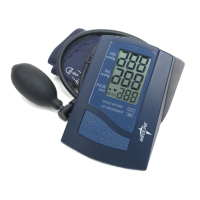3
2. Important information on blood pressure and its measurement
2.1. How does high/low blood pressure arise?
The level of blood pressure is determined in the circulatory center of the brain, and adjusts to a variety of
situations through feedback from the nervous system.
To adjust blood pressure, the strength and frequency of the heart (Pulse), as well as the width of circulatory
blood vessels is altered. The latter is effected by way of fine muscles in the blood vessel walls.
The level of arterial blood pressure changes periodically during heart activity: During the “blood ejection”
(Systole) the value is highest (systolic blood pressure value). At the end of the heart’s “rest period” (Dias-
tole) pressure is lowest. (diastolic blood pressure value).
The blood pressure values must lie within certain normal ranges in order to prevent particular diseases.
2.2. Which values are normal?
Blood pressure is too high if at rest, the diastolic pressure is above 90mmHg and/or the systolic blood
pressure is over 160mmHg. In this case, please consult your doctor immediately. Long-term values at this
level endanger your health due to continual damage to the blood vessels in your body.
Should the systolic blood pressure values lie between 140mmHg and 160mmHg and/or the diastolic blood
pressure values lie between 90mmHg and 95mmHg. Consult your doctor. Regular self-checks will be neces-
sary.
With blood pressure values that are too low, (i.e. systolic values under 105mmHg and/or diastolic values
under 60mmHg), consult your doctor.
Even with normal blood pressure values, a regular self-check with your blood pressure monitor is recom-
mended. You can detect possible changes in your values early and react appropriately.
If you are undergoing medical treatment to control your blood pressure, keep a record of values along with
time of day and date. Show these values to your doctor.
Never use the results of your measurements
to independently alter the drug doses prescribed by your doctor.
Which values are normal? : (World Health Organization)
Range Systolic Diastolic Measures
Blood pressure Blood pressure
Hypotension (low) lower than 100 Lower than 60 Consult your doctor
Normal range between 100 and 140 between 60 and 90 Monitor Regularly
Mild hypertension (high) between 140 and 160 between 90 and 100 Consult your doctor
Moderately serious between 160 and 180 between 100 and 110 Consult your doctor.
hypertension (Higher)
urgent!
Serious hypertension higher than 140 higher than 110 Consult your doctor.
(very high)
urgent!
Specific systolic higher than 140 Lower than 90 Consult your doctor
hypertension

